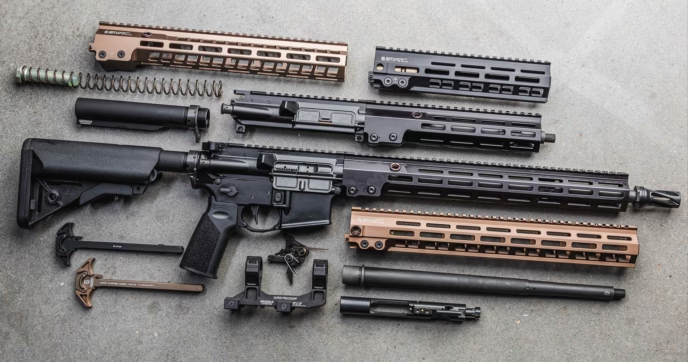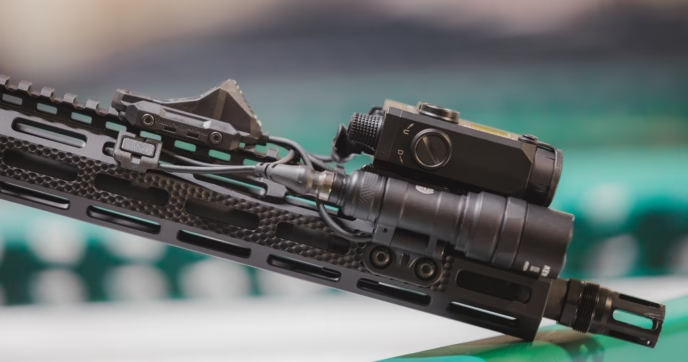Aside from optics, one of the most sought-after accessories for rifles is a suppressor—and for good reason too. Suppressors are designed to lessen a rifle’s sound signature by capturing the gases created after firing in a series of baffles, allowing them to cool and slow down before leaving the muzzle.
As such, they’ve been a staple addition for nearly every modern rifle, with them being used by enthusiasts for everything from defensive and competitive builds to hunting setups. However, while they certainly do an excellent job at mitigating sound, they’re also the cause of a few notable considerations on semi-auto platforms.
Whether you look at direct-impingement rifles like the AR-15 or piston-driven ones like the AKM, SCAR, or MCX, they all share one crucial design feature in common: they siphon gas from the barrel to cycle the action after firing. While this may seem inconsequential at first when discussing suppressors, it quickly becomes clear as to why it matters once you add one to your rifle.
Simply put, suppressors can dramatically increase a rifle’s back pressure. This increase in back pressure forces more gas through the rifle’s gas system, causing it to vent out of the receiver, inadvertently directing it right back to your face, which can seriously irritate your eyes and nose. On top of this, they’re notorious for increasing fouling as well.
Although tunable gas systems and gas busting charging handles can help in mitigating excess gas blowback, the best way to eliminate this issue is to use a suppressor that uses a low back pressure design.
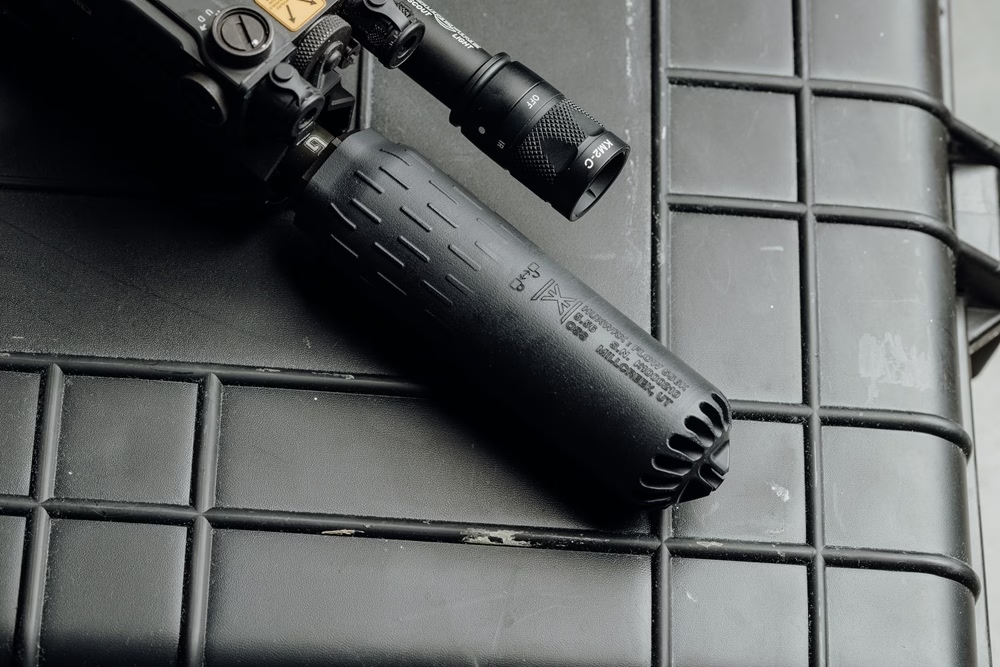
What is a Low Back Pressure Suppressor?
Before the advent of low back pressure suppressors, conventional ones were completely sealed aside from the end cap bore, which provides an exit for the bullet. While effective, such designs dramatically increase a rifle’s gas pressure. Because of this, many suppressor manufacturers have begun designing and producing low back pressure suppressor options.
Low-back pressure suppressors use specialized baffle designs with strategic vents and gas paths that are designed to minimize the amount of gas that gets forced back through the rifle’s gas system. It’s important to note that such designs do limit sound suppression, but not to a great extent—a topic we’ll touch more on later. That said, what they sacrifice in sound suppression, they make up for in user comfort and rifle performance.

Impact of Increased Back Pressure on an AR-15
To fully appreciate what low pressure suppressors can do for your set up, it’s critical to understand how increased back pressure affects your rifle. Aside from discomfort, increased back pressure can cause excess wear and tear on the internal components of your rifle. As high pressure gas is redirected through the gas port, it will erode and grow bigger over time. Now, this is natural on the AR-15 and already happens without a suppressor. However, once you add one to your rifle, you essentially accelerate the process.
Now, this isn’t to say that your AR’s barrel is suddenly going fail on you once you add a suppressor to it—a good barrel can survive upwards of 20,000+ rounds with regular maintenance, while more premium options are capable of lasting even longer. Still, increased back pressure from suppressor use can speed up the erosion process of your gas port, further increasing back pressure in the process.
Additionally, with increased back pressure, comes increased fouling. As the gas is redirected to the bolt, it comes in contact with most of your rifle’s internal components, causing carbon to build up on them. Over time, this buildup of carbon can cause potential malfunctions, meaning you’ll need to clean your rifle more often after shooting. If you have a piston-driven rifle, this won’t be as much of an issue since they typically run cleaner, but the same general principle applies.
Getting The Most out of Low Back Pressure Suppressors
A good low back pressure suppressor does a lot to undo the issues mentioned above, but they don’t eliminate excess back pressure completely. They will eliminate most of it, allowing your rifle to run cleaner and more efficiently without compromising too much on their noise suppression capabilities. But no matter what kind of suppressor you add to your rifle, they will cause an increase in back pressure to some degree. Additionally, it’s worth noting that low-back pressure and flow-through suppressors are marginally louder than conventional ones since they vent out more gas after firing.
At the end of the day though, they’re worth it simply for the added comfort and internal component longevity they provide. But to further refine your rifle, there is an assortment of accessories and components you can add to your rifle to curb the effects of increased back pressure. Parts such as adjustable gas blocks, specialized charging handles, and even your rifle’s buffer assembly can all play a significant role in improving how your rifle handles when using a suppressor.
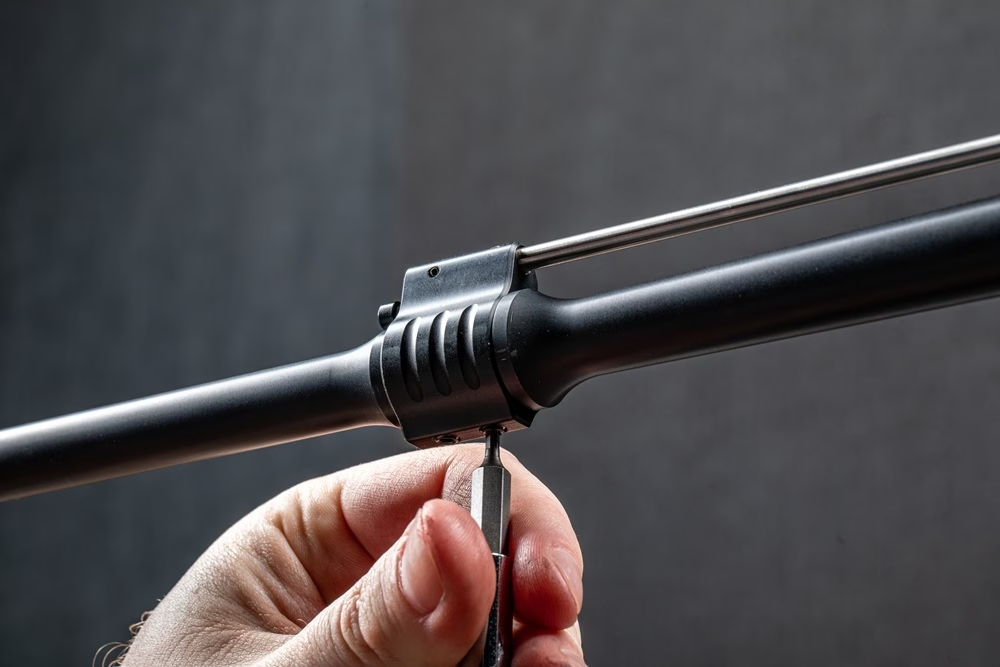
Adjustable Gas Blocks
While not true of every rifle, a lot of AR-15s are slightly over gassed to ensure they can reliably cycle different types of ammunition. Although this guarantees reliability, it can make your rifle’s recoil impulse feel a bit punchy. While adding a suppressor can help to mitigate some of the excess recoil, if your rifle is over gassed, adding a suppressor will only cause more gas to vent out of the receiver. While you can swap your barrel to one with a smaller gas port, a more practical solution is to use an adjustable gas block.
Adjustable gas blocks are exactly as their name suggests—they’re a type of gas block that houses a built-in adjustment designed to close off your rifle’s gas port. When used in conjunction with a flow-through suppressor, you can tune your gas setting to achieve the most optimal amount of gas for your rifle, further reducing excess gas blowback. This is especially beneficial when using high-pressure cartridges like 5.56 NATO with a dedicated 5.56 suppressor, or any other high-pressure cartridge with a narrow bore for that matter.
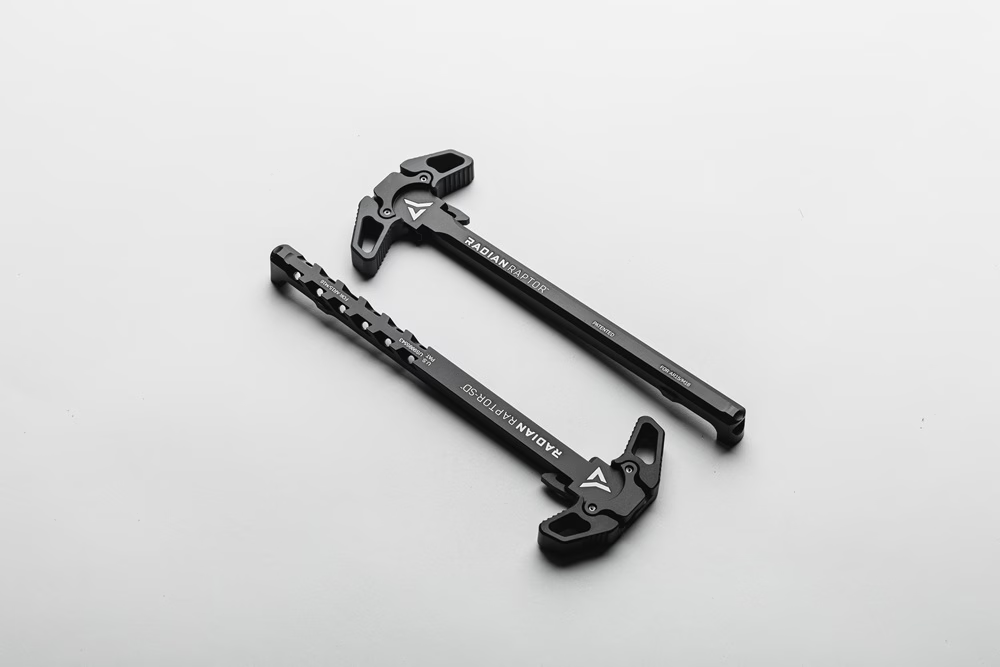
Suppressor Charging Handles
Suppressor charging handles have the same function and utility as your average AR-15 charging handle, but they come with specialized features to better protect you from over gassed rifles and increased back pressure. Notably, these charging handles can come with a series of gas-deflecting vents, or gas-blocking shelves which prevent excess gas from venting into the receiver and ejection port after firing. And when used in conjunction with a flow-through suppressor, they’re a game-changer that further protects you from gas irritation, making for a more comfortable shooting experience.
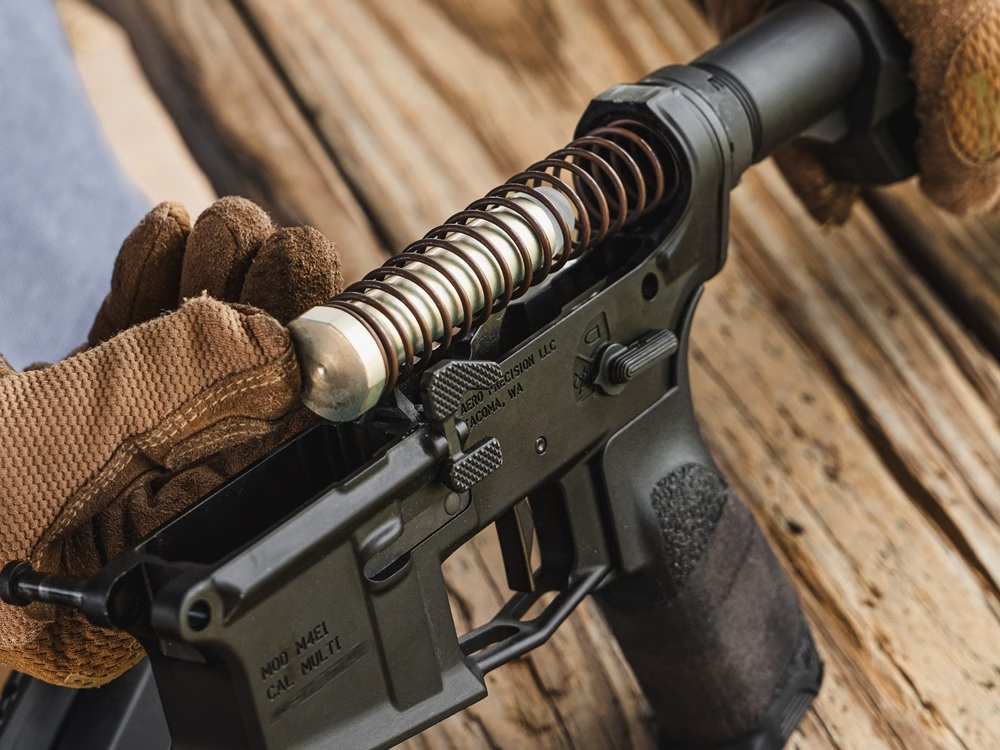
Buffer Assembly
Having the right AR-15 buffer spring and weight combination goes a long way in ensuring your rifle cycles ammunition reliably, and they also have a profound effect on your rifle’s recoil impulse. The buffer weight and spring are responsible for absorbing recoil as the BCG moves backwards to eject spent casings after firing, and they’re also responsible for pushing the BCG forward to chamber a new round and go back into battery.
A buffer that’s too light will increase your rifle’s felt recoil, while a weak spring with lower resistance will cause the BCG to slam harder into the buffer tube, further increasing felt recoil while also causing more wear on your BCG. And while a suppressor can reduce your recoil slightly, the increased backpressure they create can cause your BCG to cycle faster, causing even more wear in the process.
As such, you’ll want to make sure that your buffer assembly is the right one for suppressed shooting. Generally, heavier H2 and H3 AR-15 buffers are recommended when using a suppressor. A standard mil-spec buffer spring is a solid choice, but if you want an upgrade, a Sprinco Green, or a Geissele Super 42 braided buffer spring is exceptional for the job.
Are These Extra Components Necessary?
To put it briefly, no. Low back pressure and flow-through suppressors are designed so that you can effectively run a suppressor on a rifle with stock components. While such components can certainly aid in optimizing your rifle’s performance, they aren’t a hard requirement. Parts like adjustable gas blocks, suppressor charging handles, and specialized buffer assemblies are primarily required for conventional suppressors. So, although low back pressure suppressors tend to be more expensive than conventional ones, they don’t require the use of additional upgrades to make your rifle run efficiently.
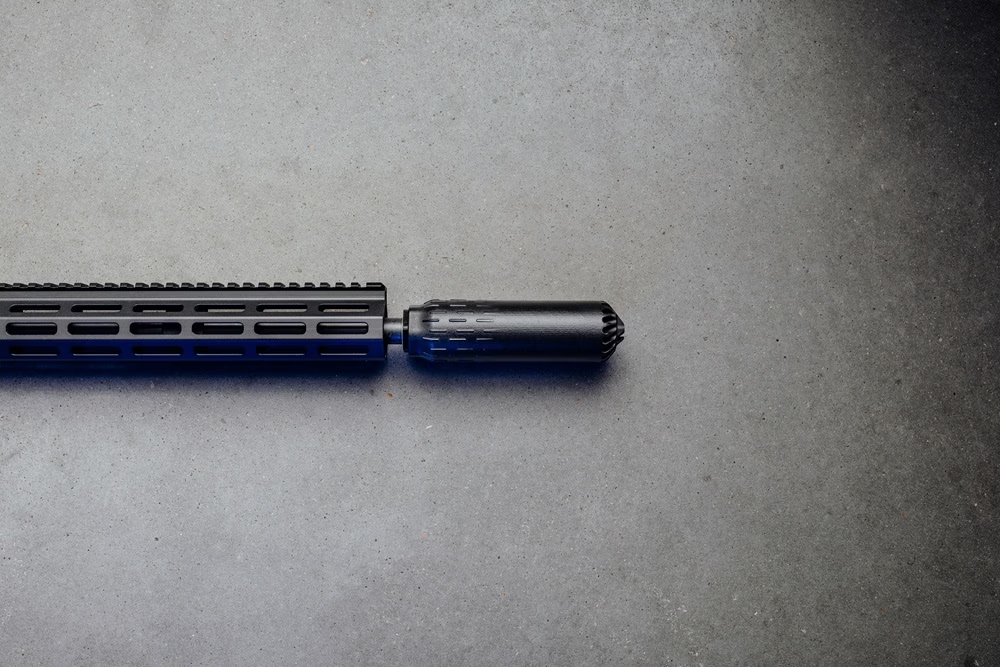
Choosing a Low Back Pressure Suppressor
With the many benefits that the right suppressor and components add to your rifle, it’s easy to understand why low back pressure suppressors have become so popular in recent years. So, in today’s industry, it isn’t really a question of whether you should use one, but rather, which one option is the best.
Brands like HUXWRX, SureFire, Maxim Defense, SilencerCo, and Otter Creek Labs, are just a few examples of top-tier brands that are home to a myriad of suppressor options designed to lower back pressure. Ideally, you’ll want to look for one that compliments your AR-15 and its purpose. Since the AR-15 can be so easily adapted to fill multiple roles, there are a wide array of suppressors tailored for the platform.
For defensive builds that emphasize agility, smaller suppressors like the HUXWRX FLOW 5.56K and SureFire SOCOM556-RC3 are a solid choice. Meanwhile, if your rifle is set up in an SPR or other long-range application, full-size suppressors like the SilencerCo Velos LBP are an excellent option that greatly reduces back pressure.
Additionally, each of the brands mentioned offer .30 Cal suppressors too, so, whether you’re looking for a dedicated 5.56 NATO or .300 Blackout suppressor, you won’t be hard pressed to find one that compliments your build.
Conclusion
While all suppressors fundamentally work to achieve the same goal of lessening your rifle’s sound signature, not all are made equal. For decades, adding a suppressor to a semi-auto rifle also meant that you would dramatically increase its back pressure, but with low back pressure and flow-through suppressors, this isn’t the case any longer.
Not only do these suppressors make your shooting experience more comfortable by decreasing the amount of the gas that spills out of the receiver, they also drastically increase the performance and longevity of your rifle. Increased backpressure can take a serious toll on your rifle’s internals, increasing wear and fouling. But with the right suppressor, and the right gear alongside it, you won’t have to worry about this as much.
Although low pressure and flowthrough suppressors do compromise slightly in terms of their overall sound suppression capabilities, the comfort they provide, as well as how they lengthen the lifespan of your rifle’s internals, more than make up for this. As such, we highly recommend taking time to research the different models available to find the right low-pressure suppressor for your next build.


